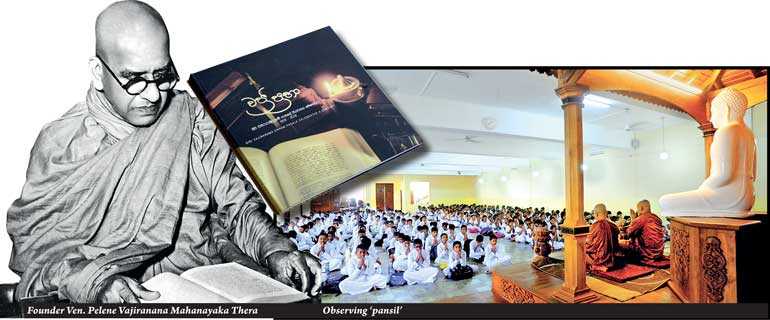Wednesday Mar 19, 2025
Wednesday Mar 19, 2025
Saturday, 15 September 2018 00:10 - - {{hitsCtrl.values.hits}}

By D.C. Ranatunga
Glancing through the first few pages in ‘Vajra Prabha’, the centenary souvenir of the Siri Vajiraramaya Dhamma School (it’s a bilingual publication), I spotted a double-page spread colour photograph of the library. My mind went back to the mid-1950s when Venerable Narada Maha Thera used to relax in an easy chair at the entrance to the library situated in the first building that can be seen as one enters the temple.
After worshipping at the Budu-ge – the image house just past the gate, then the Bodhi tree and the chiatiya, one paid obeisance to the Thera who responded with a smile full of kindness. Invariably he would have a book in his hand but he always had time to exchange a few words and discuss the Dhamma with the visitor in his soft tone.
The library building built in 1924 also had two rooms – one for the chief prelate, Most Ven. Pelene Vajiranana Maha Nayaka Thera and the other for Ven Narada. The library had been donated by Mr. and Mrs. G.J. Silva and the souvenir carries news clips from the Independent, the Times of Ceylon, the Observer and Sinhala Bauddhaya on its opening by the Colonial Secretary, Cecil Clementi CMG.
The photo in the book captures vividly the large stock of Dhamma publications neatly arranged in glass cupboards. Most of the books are Ven. Pelene Thera’s collection. In the early years there were no tables to sit and refer to books but the library has been expanded over the years.
One cannot escape discussing the origin and progress of Vajiraramaya when talking about the Dhamma School. Thus ‘Vajra Prabha’ is a publication covering the history and progress of both with, of course, the weight on how the Dhamma School has helped to build thousands of children to be worthy citizens of Sri Lanka. The apt slogan ‘Dhamma Strengthens Generations – Dhamma Enriches Sri Lanka’ sums up that service.
The book highlights the service rendered by the two pioneers Pelene Mahanayaka Thera and Narada Maha Thera in starting the Dhamma School on 18 August 1918 and building it up to be the prime ‘Sunday School’ (the term given then as the school was held on Sundays) in and around Colombo.
They were followed by Madihe Pannasiha Mahanayaka Thera assisted by Ven Ampitiye Sri Rahula, and Ven Dickwelle Mahinda, among other resident monks at Vajiraramaya.
As the years went by and as the students and staff began to increase, the administrative setup had to be streamlined. With the appointment of Sirimevan Piyasinghe as head of the Dhamma School a monk overlooked as director the school. An administrative committee was also appointed.
Pictorial record
The book is also a well-compiled pictorial record of a century’s growth of the institution. The progress of the temple and the Dhamma School over the years is vividly portrayed through photographs.
Seasoned photographer Sarath Perera and veteran art director Somachandra Peiris had teamed up to relate the story of Vajiraramaya photographically. Scenes where old photographs were not available have been recreated and the quality of the pictures in the bygone era have been improved. These have helped to enhance the value of the publication.
The book has been authored by Meegoda Sumana Thera under the guidance of the chief prelate, Tirikunamale Ananda Mahanayaka Thera and Kamburugamuwe Mahanaga Thera.
Explaining the objective of publishing ‘Vajra Prabha’, Anada Mahananaya Thera states that it is not merely to record the history over a period of 100 years but to take the past achievements through the present for rejuvenation in the future.
A valuable addition to anyone’s library.
Pix by Sarath Perera


Discover Kapruka, the leading online shopping platform in Sri Lanka, where you can conveniently send Gifts and Flowers to your loved ones for any event including Valentine ’s Day. Explore a wide range of popular Shopping Categories on Kapruka, including Toys, Groceries, Electronics, Birthday Cakes, Fruits, Chocolates, Flower Bouquets, Clothing, Watches, Lingerie, Gift Sets and Jewellery. Also if you’re interested in selling with Kapruka, Partner Central by Kapruka is the best solution to start with. Moreover, through Kapruka Global Shop, you can also enjoy the convenience of purchasing products from renowned platforms like Amazon and eBay and have them delivered to Sri Lanka.
Discover Kapruka, the leading online shopping platform in Sri Lanka, where you can conveniently send Gifts and Flowers to your loved ones for any event including Valentine ’s Day. Explore a wide range of popular Shopping Categories on Kapruka, including Toys, Groceries, Electronics, Birthday Cakes, Fruits, Chocolates, Flower Bouquets, Clothing, Watches, Lingerie, Gift Sets and Jewellery. Also if you’re interested in selling with Kapruka, Partner Central by Kapruka is the best solution to start with. Moreover, through Kapruka Global Shop, you can also enjoy the convenience of purchasing products from renowned platforms like Amazon and eBay and have them delivered to Sri Lanka.